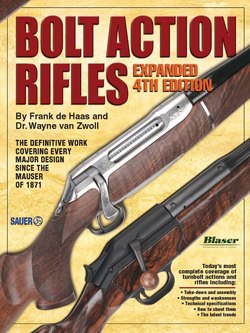Читать книгу Bolt Action Rifles - Wayne Zwoll - Страница 29
На сайте Литреса книга снята с продажи.
ОглавлениеThe Lee-Enfield action has more than ample strength for the 303 British cartridge. The two rear locking lugs are not only more than adequate to secure the bolt in the receiver, but keep the necessary bolt travel to a minimum. The threaded-in detachable bolt head is a good feature; it provided a good bolt-stop and a very convenient means to control headspace, as was done in the No. 4 rifles. The safety and trigger mechanisms are rugged and reliable. The extractor is good, but I believe it would have been a better design with a coil spring rather than a flat one, since the extractor spring is about the only part subject to breakage. There was no need for the half-cock feature. Nevertheless, Reynolds (op cit.) says that demands from field units brought the half-cock feature back; that its lack was considered dangerous. The action cocks on closing the bolt and is not liked by many shooters, but it’s really not a drawback once a person gets used to its proper operation. This goes for the double-stage trigger pull as well.
The 303 British Cartridge
Like the Lee-Enfield rifles, the 303 British cartridge proved an excellent military round. The original military loading was with a 215-grain bullet. The standard 303 British ball loading from 1910 used a 174-grain pointed full-jacketed bullet at a muzzle velocity of 2440 fps.
The No. 4 (left) and No. 1 Mark III (right) Lee-Enfield bolt heads.
Not long after its adoption in 1888, the 303 cartridge became a very popular sporting round. It was used throughout the British Empire on all kinds of game—tigers in India, small antelope to elephants in Africa, crocodiles to water buffalo in Australia, and deer to moose in Canada. Much of this shooting was done with the regular unmodified Lee-Enfield military rifle, but many double-barreled rifles chambered for it were the choice of more affluent sportsmen. Winchester chambered their Model 95 lever-action rifle for the 303 British cartridge, making the rifle popular in Canada.
Lee-Enfield firing pin removal tool.
British Lee-Enfield bolt showing: (A) bolt head; (B) extractor; (C) bolt head lug which houses the extractor and extractor spring; (D) bolt guide rib/locking lug; (E) cocking piece; (F) left locking lug and (G) gas vent hole in the bolt head.
For the most part, the only 303 British sporting loads available for many years were the 215-grain softpoint for use on thin-skinned animals and the 215-grain full-metal-cased bulleted load for thick-skinned game. American, Canadian, European, African and Australian shooters can readily purchase 303-caliber British sporting ammunition. The two most common loads will be with the 150-grain and the 180-grain bullets. The 303 British cartridge is in the same power class as the 30-40 Krag and 300 Savage. It should not be confused with the smaller 303 Savage cartridge, nor is the 303 British interchangeable with any other cartridge, although its case is nearly the same as the 30-40.
The 303 British cartridge is reloadable. It uses standard 303 (.311”-.312” diameter) bullets. Lee-Enfield barrels have a left-hand rifling twist of one turn in 10 inches; bore (land) diameter is .303”, groove diameter about .314”. Most barrels have 5 grooves, although some late-manufactured No. 4 rifles may have 2-groove barrels. The No. 4 rifles made by Savage usually have 6-groove barrels.
* These first official Lee-design rifles had barrels cut with Metford’s segmental, shallow-land rifling. The Cordite powder then used was highly corrosive, soon ruining the Metford barrels. Enfield rifling—essentially similar to today’s standard rifling, and a Metford design too, in fact— offered much deeper, and somewhat wider, lands to the hot powder gases. Barrel life was considerably extended.
